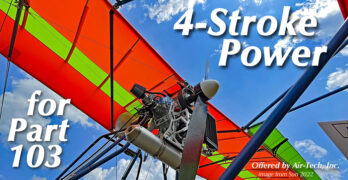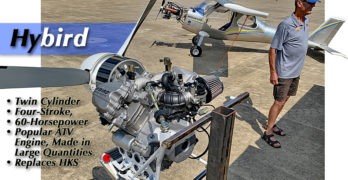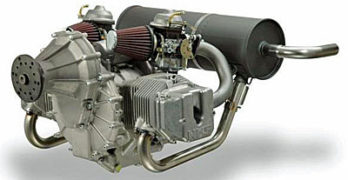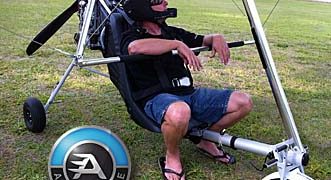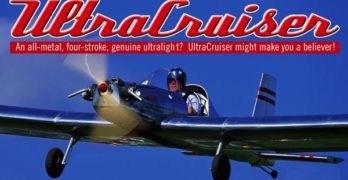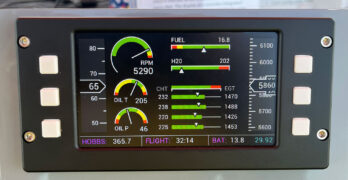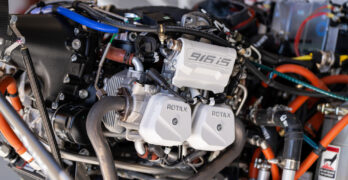If I hear one thing over and over it is this: “I want a four-stroke engine for my Part 103 ultralight. Are any available?”
For years the answer was, “Well, brand XYZ offered one but they disappeared from the market some years ago. One such winner I flew was the Bailey four-stroke out of England. However, a visit to their website recently was not very productive. Regretfully, other four-stroke powerplants are rare (although for slightly larger airplanes, Chip Erwin’s V-Twin will soon add to the choices).
Are you out of luck trying to obtain a Part 103 four-stroke? NOPE!
Aero 1000 Engine
Fine Swiss Engineeering
Air-Tech, Inc., is one of my favorite companies. While I love the people behind this Louisiana company, it isn’t their deep expertise, long experience, or even an endearing sense of humor that surrounds the Bornes — a father and son team to envy.
Search Results for : four-stroke
Not finding exactly what you expected? Try our advanced search option.
Select a manufacturer to go straight to all our content about that manufacturer.
Select an aircraft model to go straight to all our content about that model.
Welcome Hybird — New Four-Stroke Engine for Light Aircraft; Replaces HKS
A new engine was debuted at Midwest LSA Expo 2020 for light aircraft from Aeromarine-LSA. Paired as it is with a new engine-specific prop, this is a refreshing bit of news for ultralight enthusiasts and other single seat light aircraft lovers.
It’s called Hybird… and, no, I did not spell that incorrectly. As you’ll hear, the new powerplant has some possibility to be a form of hybrid (this time spelled as you expect) but it is different in that respect, too.
Since HKS decided to exit airplane engines — although our favorite datastician, Steve Beste reports he can still get parts for his HKS — the light aircraft industry has had an ear to the ground for a new four stroke replacement. It appears Chip Erwin has what many are seeking.
HyBIRD, not Hybrid
As those who know him realize, Chip does not just go out and find components for his airplanes and then adapt them to his designs.
Four-Stroke Merlin Performs Well in First Flights — See It at Sebring!
Along with many others, I’m sure, I’m presently en route from Daytona Beach to Sebring, Florida as the 2018 or 14th running of the U.S. Sport Aviation Expo is about to begin. It opens tomorrow, January 24th. By the way, it’s 82 degrees today and the forecast looks reasonably good. C’mon down!
Fresh news is breaking about the first flights of the HKS 700E-powered Merlin PSA from Aeromarine LSA.
Reporting from Lakeland, Florida yesterday, Aeromarine LSA boss Chip Erwin observed, “[Merlin with HKS is] remarkable, the difference in the feel of the airplane.” Chip’s single seater is proving increasingly popular as he logs sales for his one-seater Merlin PSA (Personal Sport Aircraft).
Having flown a number of airplanes with the smooth-running, throaty-sounding, fuel-efficient HKS, I predict continued good fortune for Aeromarine LSA. So many pilots prefer a four-stroke to a two-stroke, that — right or wrong — I imagine the Japanese engine could accelerate sales.
HKS Four-Stroke Engine is Back on the Market
A majority of pilots express a preference for four-stroke engines due to their lower noise signature, reduced fuel consumption, ease of fueling and other reasons. For larger aircraft, engines from Rotax, Continental, and Jabiru may be preferred choices but for lighter aircraft most of these engines are more than needed (though the 80-hp Rotax 912 UL and 81-hp Jabiru 2200 can work for some intermediate-sized light aircraft). All the preceding engines are more costly as well. One popular, economical choice was the HKS from Japan but that well-regarded engine appeared destined to disappear from the American market, a shame as it is one of only a few engines to have successfully complied with the ASTM standards needed for use on LSA. No such FAA acceptance is needed for Part 103 ultralight vehicles or Experimental Amateur-Built aircraft. Fortunately, to paraphrase Mark Twain, “Reports of [the HKS] death were greatly exaggerated.”
Earlier in 2014, HKS discontinued production of HKS-700E and HKS-700T.
Four-Stroke Part 103 Ultralight? Yes! And Fun…
Sometimes you’re in the right place at the right time. Well, OK, I’m biased but I think pretty much any time at Wallaby Ranch — the iconic hang gliding facility south of Disney Orlando — is a good time. When it also happens to be “Demo Days,” Wallaby is a jumping place! Demo Days is a longstanding activity where the California manufacturer, Wills Wing, brings its newest hang gliders by the truckload so that any qualified pilots can fly them for purchase evaluation. Lots of other folks show up because it’s fun and exciting but also because organizers hold the event right before Sun ‘n Fun starts.
Wallaby customers compose the perfect crowd for introducing a lightweight trike that can be flown for soaring fun. Airborne Australia is the down under manufacturer of both hang gliders and a successful line of trikes; they own SLSA status for their XT-912 and XT-912 Outback.
Lightweight Four-Stroke HKS Now Available for LSA
After Rotax announced ASTM compliance for their lightweight 582 two-stroke engine, many American pilots celebrated. This lighter, simpler powerplant (compared to the 9-series engines) gave ultralight builders seeking SLSA certification more flexibility while significantly lowering cost for buyers. Now HKS enters the arena issuing a Statement of Compliance for the horizontally opposed, twin-cylinder, four-stroke, 60-hp 700E engine. HKS is lighter than four-cylinder engines and can save buyers several thousand dollars. American importer HPower has assisted at least 29 companies as they became HKS-powered, including such leading names as RANS, Quicksilver, Murphy, Earthstar, CGS, Titan, ASAP, and Flightstar. The Japanese company, HKS Aviation Co., Ltd., made their declaration on July 16, one month after the Rotax 582. Behind HKS Aviation is real depth in a 400-employee company active in high-performance auto components. I’ve flown a number of airplanes with this engine and have become converted to its smooth power.
Four-Stroke Engines for Ultralights
Ultralights have long been defined by their two-stroke engines. Rotax and other brands refined the two-stroke for aircraft use, and today’s two-stroke powerplants deserve their popularity. In the important power-to-weight ratio, two-strokes are hard to beat. Their cost is low, their overhauls cheap; these humble powerplants have lifted many a pilot into the air for many hours.
But despite the improvements, despite plentiful businesses to help you maintain your two-stroke engine, and despite a good performance record, two-strokes are still seen as inferior to four-strokes by many aviators.
Add to these impressions the regulatory changes many see as inevitable. The blue-smoking two-stroke (even when optimized) presents environmental problems for snowmobiles, watercraft and gas-powered lawn tools. Two-stroke days are numbered—not because of efficiencies, but because of ecological concerns and political decisions.
Hail the Four-Stroke
General aviation people say, “Well, of course four stroke is better.” But that’s the only kind of engine most of them know, and their aircraft weigh enough to accommodate heavier powerplants.
All-metal, Four-stroke, Genuine Ultralight
The new light-sport aircraft (LSA) category will soon be a reality. While a best guess is that FAA’s newest rules could be announced at EAA AirVenture Oshkosh later this month, it may happen later in the year. Whenever it happens, and like many others watching closely, I hope this new concept arrives swiftly with its promise of interesting aircraft at affordable prices.
As important as LSA may be, however, the proposed new the rule doesn’t affect other enjoyable flying machines. Aircraft built under the amateur-built (51-percent) rule will continue to be a major factor. Many EAA members are building under this rule, and these aircraft will continue to offer wide choices, performance beyond that of many general aviation aircraft, and the pride of craftsmanship. LSA also leaves room for Part 103 ultralights to continue and grow. While some industry leaders see little demand for single-seat aircraft powered by small engines-and it is true that they do not make up a majority of machines-neither, however, will they disappear.
Wapsi Aero Debuts Multifunction Display at AirVenture
If you are piloting an ultralight or light plane VFR, you really don’t need an artificial horizon or a heading indicator. But you do need airspeed and altitude, and it’d be nice to have that available in a compact, clear, modern package. Even better, you’d like to make sure everything is happy in the power barn, as well as your airspeed and altitude.
In the spirit of providing everything you need and nothing you don’t, Wapsi Aero brought a bright and affordable electronic flight instrument that has generated quite a bit of buzz at AirVenture’s ultralight field. The rectangular instrument provides graphical engine data mid screen with airspeed and altitude in legible tape readouts on each side—combining a partial EFIS with an engine monitor. The screen is bright and easily readable, even in direct sunlight. The instrument also provides Hobbs and flight timers as well as battery voltage.
Even better, the Wapsi device is designed to fit into the same hole that may currently house a GRT EIS engine monitor—of which there have to be thousands in the field.
Crystal Balling — What Will Rotax Do Next?
Untethered prognostication is what you do waiting for the rain showers to blow through and the sun to reemerge on your long cross country. Me? I sorta do it for a living. (Such as that is.) And I get to do it often enough in front of people who work deep in the industry to see if I’ve landed close to the truth. Like playing Battleship with engineers and PR people.
My latest prognostication jag centers on what’s next for Rotax. And it’s driven by a feeling that there’s no time to waste moving up the horsepower ladder. Here’s my argument.
First, the traditional engine manufacturers have still not recovered from what they say are pandemic-related supply-chain issues, which causes huge delays in deliveries and helps drive prices quite high. In the Experimental realm, where I also live, new engines have become exceptionally more expensive, leading some builders to reassess their budgets and stop their projects where they stand.
- 1
- 2
- 3
- …
- 13
- Next Page »


